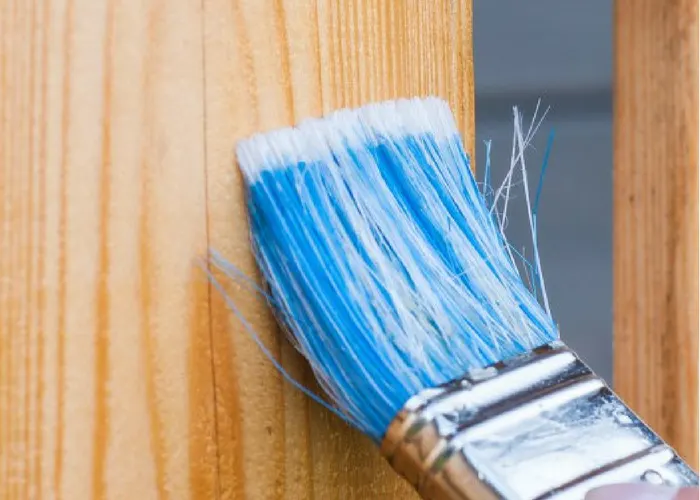Once you’ve decided on a stain finish for a project, the next step is to choose a brush.
But what type of brush do you use for stain?
Can you use a rag?
What about a brush for the polyurethane top coat?
With so many options out there, it can be difficult to figure out what’s what.
No fear, my friend.
Here are the answers to all your problems!
This post contains affiliate links. See my full disclosure here. Thankyou for supporting Bitterroot DIY!
The Basics
Use a high-quality brush or rag.
Does that mean I haven’t done many a project with the dollar fifty brushes from Wal-Mart or the torn up t-shirt I found in the garage … No.
In fact, I just recently purchased my first “fancy” brush.
*insert happy dance*
And I will say that it makes a difference:
- A high-quality brush carries more stain, so the job goes much quicker
- Fewer runs and drips
- No bristles falling off into the finish
- Responds better to cleaning and storage (aka: it will last longer)
- You feel so much cooler … and confidence is key #amirighttt
Wooster makes some great high-quality brushes, as do Purdy and Minwax.
In general, use a synthetic bristle brush for water-based stains and finishes, and use a natural bristle brush for oil-based stains and finishes.
Stain
To brush, or not to brush: that is the question. Whether ’tis nobler in the mind to suffer the runs and drips of outrageously cheap brushes, or to use cloth against a sea of stain … It’s really up to you.
… that didn’t conclude quite as elegantly as Shakespeare would’ve liked, but it’ll do …
Stain can be applied with a bristle brush, foam brush, or a cloth. I’ve used all three methods, and each one has it’s advantages and disadvantages.
Bristle Brush
Advantages: Bristle brushes carry a substantial amount of stain for quick, full coverage. This is especially helpful on softwoods that soak up quite a bit of stain.
Disadvantages: Look out for of brush marks, runs, and drips.
Application: Apply stain with bristle brush – synthetic bristle brush for water-based, natural bristle brush for oil-based. Let sit on the wood for the specified amount of time, per the instructions on the can (typically a few minutes). Remove any excess stain with a lint-free cloth, wiping in the direction of the wood grain.
Foam Brush
Advantages: Foam brushes also carry a substantial amount of stain for quick, full coverage.
Disadvantages: Quite a few brush marks, runs, and drips. I’ve also noticed uneven coverage when I’ve used foam brushes simply because the stain soaks out of the brush at different rates. However, it’s not a terrible issue since you have to wipe off excess stain at the end anyways.
Application: Apply stain with foam brush. Let sit on the wood for the specified amount of time, per the instructions on the can (typically a few minutes). Remove any excess stain with a lint-free cloth, wiping in the direction of the wood grain.
Cloth
Advantages: Simply wipe the stain on with a lint-free cloth or stain pad and you’re good to go. Easy peasy! No need to brush on, wait for it to soak, and then wipe off.
Disadvantages: The only issue I’ve noticed with wiping rather than brushing is that you don’t always get as much coverage in one coat. Since there isn’t any excess stain left on the wood surface to soak in, the stain doesn’t penetrate the wood surface as well. It’s a minor thing really … simply apply an extra coat if necessary.
Application: Make sure the lint-free cloth or stain pad is adequately saturated with stain. Work the stain into the pores of the wood by rubbing in a circular motion. Once you’ve worked enough stain for the wood to absorb, wipe the cloth or stain pad in the direction of the wood grain to remove any swirls or uneven lines.
Finish Top Coat
Once you’ve got your piece looking nice and pretty, stained and styled, it’s time to seal the deal. It’s especially important to use a high quality bristle brush when applying a finish top coat. That’s the whole reason I finally bought a ‘fancy’ brush … it’s incredibly difficult to get a smooth finish without a high-quality brush.
Same as for stain, the Rule of Thumb for finishes: use a synthetic bristle brush for water-based finishes, and use a natural bristle brush for oil-based finishes.
Let me know if you have any questions and I’ll get back to you as soon as possible!
Thanks for stopping by Bitterroot DIY!
To stay up to date with the latest shenanigans, follow me on Instagram.
And for more DIY projects and home inspiration, you can find me on Pinterest.


Craig Soulliard
Tuesday 30th of June 2020
As a first time stainer your information was exactly what I need to get started. Thank you.
tylynn_sattler
Tuesday 30th of June 2020
Glad it helped!
Shawn
Tuesday 11th of February 2020
Can a brush that's previously been used with oil based stains (or finishes) be used later with water based finishes such as polycyclic?
tylynn_sattler
Thursday 13th of February 2020
I think it's best to try to keep separate brushes for each, but I've done it before (as long as the brush was cleaned really well). Technically, you should use natural bristle brushes for oil-based finishes and nylon/polyester/synthetic bristle brushes for water based finishes for the smoothest finish. But sometimes all you have is an old sock anyways ... ;)